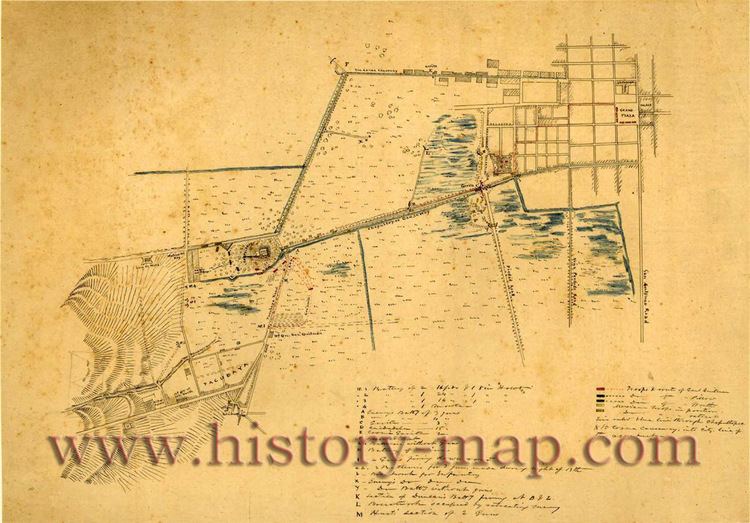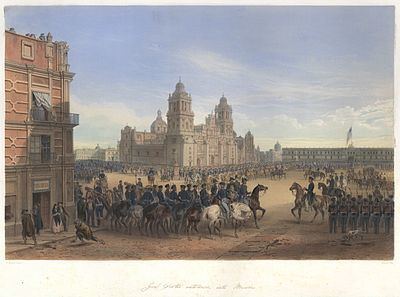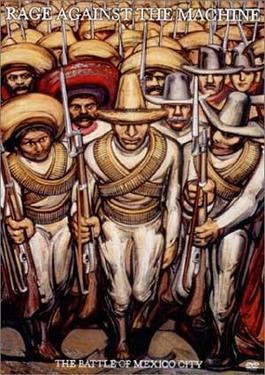7,157 16,000 | Dates 8 Sep 1847 – 15 Sep 1847 | |
 | ||
~1,651 killed or wounded ~2,323 killed or wounded,~3,000 captured Result Decisive United States victory Similar Mexican–American War, Siege of Veracruz, Battle of Cerro Gordo, Battle of Churubusco, Battle of Buena Vista | ||
The Battle for Mexico City refers to the series of engagements from September 8 to September 15, 1847, in the general vicinity of Mexico City during the Mexican-American War. Included are major actions at the battles of Molino del Rey and Chapultepec, culminating with the fall of Mexico City. The U.S. Army under Winfield Scott scored a major success that ended the war.
Contents
- Background
- Molino del Rey
- Chapultepec
- Attacks on the Beln and San Cosme Gates
- Fall of Mexico City
- United States
- Mexico
- September 8
- September 1215
- Totals
- References

Background

The major objective of American operations in central Mexico had been the capture of Mexico City. After capturing the port of Veracruz in March, General Winfield Scott was able to secure a base and move inland and defeat a large Mexican force at the Battle of Cerro Gordo. After routing the Mexicans at the Battle of Churubusco, Scott's army was only five miles (8 km) away from its objective of Mexico City.
Although defeated at Cerro Gordo and Churubusco, General Santa Anna's army remained intact and outnumbered Scott.
Molino del Rey

On September 8, the fight for Mexico City began. Scott believed that a cannon foundry was located at the Molino del Rey, the King's Mill, located just over 2 miles (3 km) outside the city. Scott sent the 1st Division under William J. Worth to seize and destroy the foundry. Worth wished to include Chapultepec Castle in his attack, and when Scott refused, a bitter rivalry began between Scott and Worth. In the ensuing battle, both sides suffered heavy casualties, and Worth drove the Mexicans from the mill, separating them from the forces at Chapultepec. The battle produced no significant military gains for the U.S.
Chapultepec

The main assault on the city came a few days later on September 12. Mexico City was guarded in part by Chapultepec Castle, which was being used as a military academy. Scott preceded infantry assault with an all day artillery barrage on September 12. The next day, September 13, the 4th Division, under John A. Quitman, spearheaded the attack against Chapultepec and carried the castle. Future Confederate generals George E. Pickett and James Longstreet participated in the attack. Serving in the Mexican defense were the cadets later immortalized as Los Niños Héroes (the "Boy Heroes"). The Mexican forces fell back from Chapultepec and retreated within the city.
Attacks on the Belén and San Cosme Gates

Quitman's Division made its way down the Belén Causeway towards the Belén Gate, defended by General Terres & Colonel Garay with the 2d Mexico Activos (200 men) and 3 guns ( 1-12 lbs. & 2-8 lbs.), while Worth's Division further to the north made its way up La Verónica Causeway towards the San Cosme Gate, defended by General Rangel's Infantry Brigade (Granaderos Battalion (Adj. A. Manero), 1st Light(Comdte. L. Marquez), part 3d Light (Lt.Col. M.M. Echeagaray)and parts of Matamoros, Morelia and Santa Ana Battalions (Col. J.V. Gonzalez) with 3 guns (1-12 lb, 1-8 lb. and 1 howitzer 24 lbs. Quitman was merely supposed to make a feint towards the city, but he pushed forward his whole division and broke through the defenses. Santa Anna arrived at the Belén Gate in a fury and relieved the front commander. Worth's Division in the meantime had a slow start against the Mexicans after beating off a Mexican cavalry attack. When he reached San Cosme, he found its defenses ill prepared, but the Mexicans defending it put up a good fight before falling back. Ulysses S. Grant found his way into the action along the causeway on Worth's front and helped in hoisting a cannon into the belltower of a nearby church. From this spot Grant fired into the defenders below. When the fighting subsided on all fronts, both gates had fallen and the Mexicans had withdrawn into the city. Other gates defended were: San Antonio by General M. Martínez ( 3d & 4th Ligero & 11th Line with 10 guns ) before withdrawing; Nino Perdido by the National Guards and 2 guns; and San Lázaro, Guadalupe and Villejo, which were defended by small infantry detachments. Other forces were stationed at la Piedad (1st & 2d Mexico Activos and Guanajunto Battalions), the Insurgente bridge (Gen. Arguelles : Invalidos and Lagos Battalion) and in the rear of these (Gen. Ramirez with 2d Ligero and various pickets) before withdrawing to the Citadel.
Fall of Mexico City
The Junta (Gens. Alcorta, Carrera, Lombardini & Fran. Pérez) had withdrawn their army: 14 Guns, 4,000 Cavalry (Quijano & Andrade Brigades), and 5,000 Infantry (Four Sections: -1.) Gov. Olaguibel: Toluca National Guards, -2.) Cmdte. Arroyo: Lagos, Iturbide, & Tula Battalions, -3.) Gen. Martínez: various pickets, and -4.) Gen. Pérez: 11th Infantry & remnants of Light Regts.) from the city during the night, and the U.S. forces, expecting another assault, found the city undefended. Worth and Quitman advanced cautiously. Quitman sent Lieutenant Pierre Beauregard to arrange the surrender of the ciudadela. Beauregard and Mansfield Lovell were met by a Mexican officer who asked for a receipt for the captured ciudadela.( 15 Guns) Beauregard exclaimed that "we give receipts at the point of their swords". Scott gave the honor of formally entering the city to Quitman's Division. The conquering army was less than impressing, the troops wore ragged and bloodstained uniforms and Quitman only had on one shoe when he marched into the city. Quitman marched into the Zócalo plaza in the center of the city in front of the National Palace where the formal surrender took place. As Worth's division entered the city the leading unit was John Garland's brigade.
Stragglers from the Mexican army left in the city after Santa Anna's withdrawal climbed to the roofs of houses and began shooting at the American soldiers. General Garland was hit in the chest with the first shot and fell severely wounded. Before he evacuated, Santa Anna released 30,000 prisoners into the streets of the city, and these rooftop shots provoked the prisoners into similar acts. Worth did manage to get the sniping under control. William S. Harney's dragoons escorted General Scott into the city wearing his immaculate dress uniform and was greeted by patriotic music. Scott appointed the politically savvy Quitman as military governor, becoming the only American to ever rule from the National Palace.
United States
US Army - Major General Winfield Scott
Mexico
7 August 1847—20,210 men and 104 artillery pieces acs
Mexican Army General Antonio López de Santa Anna
Chief of Artillery: General Martin Carrera
Chief of Engineers: General Ignacio Mora y Villamil
Alcaraz, Ramon "Apuntes para la historia de la guerra entre Mexico...†
